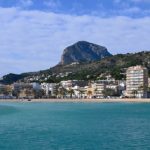Nestled along Spain’s Costa Blanca, Jávea, or Xàbia as it’s known in Valencian, is a Mediterranean paradise. With its sun-soaked beaches, azure waters, and charming old town, Jávea attracts visitors from around the world. One of the most common questions among potential travelers is: "When is the best time to visit Jávea?" The answer largely depends on your preferences for weather, activities, and crowd levels. This seasonal guide breaks down the highlights of Jávea throughout the year to help you choose the ideal time for your visit.
Spring (March to May): Blooming Beauty and Pleasant Temperatures
Spring in Jávea is a delightful season, marked by moderate temperatures and vibrant natural beauty. Average highs range from 17°C (63°F) in March to 23°C (73°F) in May, making it ideal for outdoor activities.
- Why Visit in Spring?
- Mild Weather: Perfect for exploring the Montgó Natural Park or walking along the coastal trails without the heat of summer.
- Fewer Crowds: Beaches like Arenal and La Granadella are quieter compared to the peak season.
- Festivals: April and May host traditional Spanish festivals, offering a chance to experience local culture.
Spring is also a great time for culinary enthusiasts to indulge in Jávea’s local dishes, such as arroz a banda (seafood rice) and freshly caught fish, at less crowded restaurants.
Summer (June to August): Sun, Sand, and Festivities
Summer is Jávea’s peak tourist season, and for a good reason. The town comes alive with vibrant energy, and the Mediterranean weather is at its best.
- Why Visit in Summer?
- Beach Days: With average highs of 30°C (86°F), summer is ideal for swimming, snorkeling, and sunbathing on Jávea’s pristine beaches.
- Water Sports: Kayaking, paddleboarding, and jet skiing are popular activities during this time.
- Festivals: The town’s iconic "Fiestas de Sant Joan" in June features bonfires, music, and dancing, while August brings the "Mare de Déu de Loreto" festival with maritime processions and fireworks.
However, it’s worth noting that Jávea can get crowded during the summer months. Booking accommodations and activities well in advance is recommended.
Autumn (September to November): Golden Hues and Tranquility
Autumn in Jávea is a quieter, more relaxed season. The weather remains warm in September, gradually cooling as November approaches.
- Why Visit in Autumn?
- Pleasant Temperatures: Ranging from 27°C (81°F) in September to 18°C (64°F) in November, the weather is perfect for outdoor adventures.
- Less Crowded Beaches: Enjoy the beauty of Jávea’s beaches without the summer crowds.
- Wine Harvest Season: The region’s vineyards come alive during the grape harvest, offering wine-tasting tours and events.
Autumn is also a fantastic time for hiking. Trails in Montgó Natural Park or along the cliffs of Cabo de la Nao offer breathtaking views of the coastline.
Winter (December to February): Mild Winters and Local Charm
Jávea enjoys one of the mildest winters in Europe, making it a year-round destination. While it’s too cool for swimming, there are plenty of other activities to enjoy.
- Why Visit in Winter?
- Mild Weather: Daytime highs hover around 16°C (61°F), and the sunshine is abundant.
- Cultural Experiences: Explore Jávea’s Old Town with its historic buildings, narrow streets, and weekly markets.
- Relaxation: The town is serene, making it perfect for unwinding away from the hustle and bustle.
Winter is also a great time to explore Jávea’s culinary scene. Restaurants often feature hearty seasonal dishes, including stews and local wines.
Choosing the Best Time Based on Your Interests
- For Beach Lovers: Summer is unbeatable, offering warm waters and vibrant energy.
- For Adventure Seekers: Spring and autumn provide the best conditions for hiking, cycling, and other outdoor activities.
- For Culture Enthusiasts: Visit during festivals in summer or explore the Old Town in winter.
- For Relaxation: Winter and autumn are ideal for a tranquil escape.
Travel Tips for Visiting Jávea
- Book Early: Summer accommodations fill up quickly, so plan ahead if you’re visiting during peak season.
- Pack Accordingly: Lightweight clothing and sunscreen for summer; layers and comfortable shoes for winter.
- Try Local Cuisine: Don’t miss out on Jávea’s paella, fresh seafood, and local wine, no matter when you visit.
- Explore Beyond Beaches: Visit the old town, local markets, and nearby attractions like Denia and Altea.
- Check Festival Dates: If you’re interested in cultural events, research Jávea’s festival calendar beforehand.
Conclusion
Jávea is a destination that offers something special in every season. Whether you’re drawn by the sun-soaked beaches of summer, the tranquil beauty of autumn, the blossoming landscapes of spring, or the mild charm of winter, this coastal gem promises an unforgettable experience. Plan your trip based on your preferences and discover the unique allure of Jávea, no matter the time of year.
Frequently Asked Questions (FAQs)
What is the best month to visit Jávea for beach activities?
July and August are ideal for beach activities, with warm weather and calm waters
Are there any festivals in Jávea during spring?
Yes, Jávea hosts traditional Spanish festivals in April and May, offering cultural experiences
Is Jávea crowded in autumn?
No, autumn is less crowded, making it a peaceful time to enjoy the town’s attractions
What activities can I enjoy in Jávea during winter?
Winter is perfect for exploring the Old Town, hiking, and enjoying local cuisine
Which season is best for hiking in Jávea?
Spring and autumn are ideal for hiking due to moderate temperatures and scenic beauty





